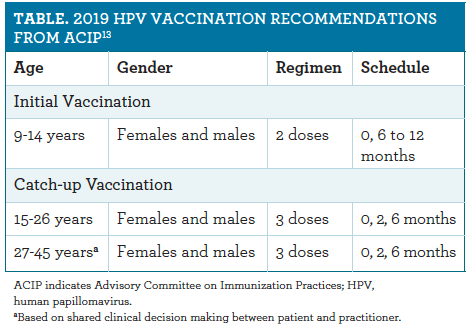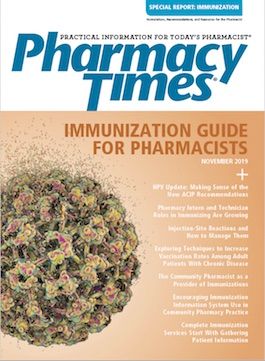Publication
Article
Supplements
HPV Update: Making Sense of the New ACIP Recommendations
Author(s):
Previously, vaccination was not recommended for patients in a certain age range, as there was no demonstrated benefit to HPV vaccination; however, this is about to change.
Human papillomavirus (HPV) is the most common sexually transmitted infection in the United States, affecting some 79 million individuals.1 Infection with HPV has been linked to genital warts and 6 types of cancer.2
Because the virus can clear on its own and cause no health problems, many people may be unaware they are infected and may unknowingly spread the virus to a partner. About 14 million new cases of HPV are documented in the United States each year.2 Individuals aged 15 to 24 years accounted for about 49% of new infections in 2013-2014. The remaining infections occured in adults 25 years and older: 35% of women and 45% of men aged 25 to 49 years had an HPV infection.3 Previously, vaccination was not recommended for patients in this age range, as there was no demonstrated benefit to HPV vaccination4; however, this is about to change.
HPV VACCINATION IN THE UNITED STATES
Data from 2010 indicate that about 20% of adolescent females were vaccinated with at least 1 dose of the HPV vaccine, compared with 0.6% of adolescent males; up to 69% of adolescent females and 63% of adolescent males were vaccinated in 2017.5 The challenge of vaccinating patients continues, however, because of both social stigma surrounding the vaccine and guideline restrictions for vaccinating individuals older than 26 years. As of 2016, it was estimated that each day, more than 8000 Americans aged out of the recommendation,6 putting all of them at risk of contracting HPV and potentially experiencing its complications.
The HPV vaccine was first recommended for female patients in 2006, and administration to male patients was recommended in 2011. Currently, 1 HPV vaccine is available in the United States, the 9-valent HPV (9vHPV) vaccine (Gardasil 9; Merck).7 It was introduced to the market in 2015 and by the end of 2016, all other HPV vaccines were removed from the market.
The 9vHPV vaccine covers 9 strains of the HPV virus (6, 11, 16, 18, 31, 33, 45, 52, 58). It is administered intramuscularly in the deltoid region of the upper arm or in the higher anterolateral area of the thigh. The most commonly reported adverse reactions are injection-site pain and swelling. In addition, the package insert includes a warning for syncope and suggests monitoring patients for 15 minutes after injection.7
PREVIOUS HPV VACCINATION RECOMMENDATIONS
Routine HPV vaccination was previously recommended by the CDC’s Advisory Committee on Immunization Practices (ACIP) for all patients 11 to 12 years of age, with an option of starting as early as 9 years, using a 2-dose series given at 0 and 6 to 12 months. Catch-up vaccination was recommended for females and certain male populations through age 26 and all males through age 21. The recommendation also stated that males aged 22 to 26 years may be vaccinated based on individual clinical decision. Patients beginning the series after 15 years of age would receive a 3-dose series given at 0, 1 to 2 months, and 6 months. The recommendation for males up to age 26 specifically indicated that men who have sex with men, immunocompromised males, and HIV-positive males should be vaccinated.8
All this begs the question, why not vaccinate patients older than 26 years?
2019 HPV VACCINATION RECOMMENDATIONS
The ACIP sought to answer that question and another one at their June 2019 meeting: First, should catch-up HPV vaccination be recommended for primary prevention of HPV infection and HPV-related disease for all persons through age 26 years? And second, should catch-up HPV vaccination be recommended for primary prevention of HPV infection and HPV-related disease for all persons aged 27 through 45 years?9 The first question was intended to synchronize female and male vaccination schedules, and the second to address vaccinating older patients. It is important to note that the FDA approved the 9vHPV vaccine for patients aged 9 to 45 years in October 2018.10
Data presented at the meeting regarding the safety and immunogenicity of using the HPV vaccine in females aged 27 to 45 years of age showed that women in that age range are at risk of infection by the virus types included in the 9vHPV vaccine. The 9vHPV vaccine was also shown to be effective in women aged 27 to 45 years, regardless of age, with more than 99% seroconversion and an antibody response that was not inferior to that of younger patients. The vaccine also was shown to be well tolerated in this patient group and the findings supported the benefits of vaccinating patients aged 27 to 45 years of age.11
Furthermore, the results of a cost analysis for harmonizing the catch-up indication for males and females up to age 26 indicated an estimated cost increase of about 5% for harmonizing the catch up to age 26. This cost increase was considered to be minimal. Conversely, the analysis showed that extending the recommended vaccination age to 45 years would produce small health benefits; the number needed to vaccinate to prevent 1 case of disease would be 40 times higher in patients through 45 years of age than in patients aged through 26 years. In addition, the results of the analysis showed that the cost to extend this recommendation to age 45 was significantly higher as compared with patients through age 26 years.12
Based on these data and evidence, the ACIP voted to make the following changes to the recommendations: harmonizing the catch-up schedule to all patients through age 26, regardless of gender; and recommending that the HPV vaccine be provided for patients aged 27 to 45 years based on shared clinical decision making between the patient and their health care provider. These new recommendations are summarized in the table.13

The ACIP also recognized the need to focus vaccination efforts on the adolescent population, as the vaccine is most effective before a patient is exposed to the virus. At this time, the ACIP is not recommending that patients over 26 years of be routinely screened; however, they specifically stated that patients at any age are at risk of contracting the virus and thus may benefit from vaccination. Persons in long-term, mutually monogamous sexual partnerships are unlikely to acquire new HPV infections.14
HOW CAN PHARMACISTS HELP SUPPORT THESE NEW RECOMMENDATIONS?
With these changes in recommendations for the HPV vaccine, pharmacists have an opportunity to engage new populations of patients and help provide needed protection. Reports have shown that 26% of adults aged 18 to 29 years do not have a primary care provider, and instead tend to use walk-in clinics and pharmacies for vaccines.15,16 As such, it is imperative that pharmacists are aware of the recommendation changes and that they engage this population.
Previously, pharmacists had to interpret individualized data to determine if a patient was at risk of acquiring HPV. This led to lower vaccination rates and increased incidence of HPV infection in men compared with women.3,5 The harmonization for male and female patients up to age 26 will help pharmacists in identifying at-risk patients and ensure that these patients are protected by receiving catch-up doses.
In addition, the new recommendation for vaccinating patients up to age 45 opens the door to pharmacists to help patients understand the value and importance of protection, and through shared decision making pharmacists can help patients determine if they should receiving the vaccine.
The new HPV recommendations may contribute to confusion for patients, and they may seek clarification from their pharmacist. As with any change in vaccine recommendations, pharmacists should be equipped to discuss these changes with their patients. Armed with this knowledge and as one of the most accessible health care providers, pharmacists have an opportunity to take the lead in their communities to help educate their patients and protect them from vaccine-preventable illnesses such as HPV.
CHRIS D. ALTMAN, PHARMD, is the clinical manager for immunizations at Rite Aid in Harrisburg, Pennsylvania.
REFERENCES
- Genital HPV infection — fact sheet. CDC website. cdc.gov/std/hpv/stdfact-hpv. htm. Reviewed November 16, 2017. Accessed September 1, 2019.
- About HPV. CDC website. cdc.gov/hpv/parents/about-hpv.html. Reviewed April 29, 2019. Accessed September 1, 2019.
- Lewis RM, Markowitz LE, Gargano JW, Steinau M, Unger ER. Prevalence of genital human papillomavirus among sexually experienced males and females aged 14-59 years, United States, 2013-2014. J Infect Dis. 2018;217(6):869-877. doi: 10.1093/infdis/jix655.
- Satterwhite CL, Torrone E, Meites E, et al. Sexually transmitted infections among US women and men: prevalence and incidence estimates, 2008. Sex Transm Dis. 2013;40(3):187-193. doi: 10.1097/OLQ.0b013e318286bb53.
- Walker TY, Elam-Evans LD, Yankey D, et al. National, regional, state, and selected local area vaccination coverage among adolescents aged 13-17 years — United States, 2017 [published correction appears in MMWR Morb Mortal Wkly Rep. 2018;67(41):1164. doi: 10.15585/mmwr.mm6741a8]. MMWR Morb Mortal Wkly Rep. 2018;67(33):909-917. doi: 10.15585/mmwr.mm6733a1.
- Vital Statistics of the United States, 2003, Volume 1, Natality. Centers for Disease Control and Prevention, 2013. CDC website. cdc.gov/nchs/data/statab/ natfinal2003.annvol1_01.pdf. Accessed September 1, 2019.
- GARDASIL 9 [prescribing information]. Whitehouse Station, NJ: Merck & Co, Inc; 2018. fda.gov/media/90064/download. Accessed September 1, 2019.
- Recommended adult immunization schedule for ages 19 years or older, United States, 2019: human papillomavirus vaccination. CDC website. cdc.gov/vaccines/ schedules/hcp/imz/adult.html#note-hpv. Reviewed February 5, 2019. Accessed September 1, 2019.
- Szilagyi P. Human papillomavirus vaccines session; presented to Advisory Committee on Immunization Practices. CDC website. cdc.gov/vaccines/acip/ meetings/downloads/slides-2019-06/HPV-1-Szilagyi-508.pdf. Published June 26, 2019. Accessed September 1, 2019.
- FDA approves expanded use of Gardasil 9 to include individuals 27 through 45 years old [news release]. Silver Spring, MD: FDA; October 5, 2018. fda. gov/news-events/press-announcements/fda-approves-expanded-use-gardasil-9-include- individuals-27-through-45-years-old. Accessed September 1, 2019.
- Luxembourg A. 9-valent HPV (9vHPV) vaccine program safety and immunogenicity study in women 27-45 years; presented to Advisory Committee on Immunization Practices. CDC website. cdc.gov/vaccines/acip/meetings/downloads/ slides-2019-06/HPV-3-Luxembourg-508.pdf. Published June 26, 2019. Accessed September 1, 2019.
- Chesson H. Overview of health economic models for HPV vaccination of mid-adults; presented to Advisory Committee on Immunization Practices. CDC website. cdc.gov/vaccines/acip/meetings/downloads/slides-2019-06/HPV-4- Chesson-508.pdf. Published June 26, 2019. Accessed September 1, 2019.
- Markowitz L; National Center for Immunization & Respiratory Diseases. Work group considerations: proposed recommendation text for policy options; presented to Advisory Committee on Immunization Practices. CDC website. cdc. gov/vaccines/acip/meetings/downloads/slides-2019-06/HPV-6-Markowitz-508. pdf. Published June 26, 2019. Accessed September 1, 2019.
- Meites E, Szilagyi PG, Chesson HW, Unger ER, Romero JR, Markowitz LE. Human papillomavirus vaccination for adults: updated recommendations of the Advisory Committee on Immunization Practices. MMWR Morb Mortal Wkly Rep. 2019;68(32):698-702. doi: 10.15585/mmwr.mm6832a3.
- Boodman SG. Spurred by convenience, millennials often spurn the ‘family doctor’ model. Kaiser Health News website. khn.org/news/spurred-by-convenience- millennials-often-spurn-the-family-doctor-model/. Published October 9, 2018. Accessed September 1, 2019.
- Millennials bring online and do-it-yourself consumer behaviors to health care interactions. Employee Benefit Research Institute website. ebri.org/docs/defaultsource/ fast-facts/ff-297-millennialhealthcare-5mar18.pdf?sfvrsn=433b342f_2. Published March 5, 2018. Accessed September 1, 2019.







